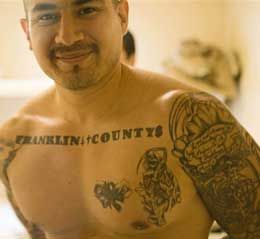 Jimmy McIntosh shows off his tattoos in a new prison unit that is part of the gang violence reduction measures at the Washington State Penitentiary in Walla Walla, Wash., on Tuesday, Feb. 3, 2009. Tattoos are one way that prison officials determine gang affiliation in order to separate rival groups. (AP Photo/Jackie Johnston) |
Related Resources: |
By Shannon Dininny
Associated Press
WALLA WALLA, Wash. — Robert Walker is a recent arrival to the new gang unit at the Washington State Penitentiary. He likes his new home, as far as anyone can like prison.
“It’s cleaner and there’s less people,” said the 21-year-old former gang member from Seattle who is serving 18 years for assault. “The room is bigger, but you know...”
Walker’s voice trailed off and he shrugged his shoulders at his surroundings - an open cell block offering officers an easy view of rooms from a central command post.
The unit is a far cry from the prison blocks of the past that had a line of cells three stories high overlooking a wide hallway. In an attempt to curb prison violence, largely among gang members, the prison has begun isolating problem inmates and gang members in pods to restrict their interaction with other inmates.
“Overall, because we’ve been able to manage the offenders in smaller groups - groups of 99 - we’re able to minimize the incidents,” said Steve Sinclair, the prison superintendent.
Gang members make up 18 percent of Washington’s prison population of about 17,000 inmates, but they account for 43 percent of all major violent infractions inside the prisons, according to a report released last month by the state Department of Corrections.
In the past year, prison officials have taken steps to address the problem, by conducting more comprehensive reviews of inmates when they are first admitted to the state prison system. Since July, identified gang members have been steered from there to the four new gang units in Walla Walla.
In just seven months, the number of violent incidents has declined by about 200 from the previous year, or about 20 percent, said Dan Pacholke, Corrections Department deputy director. That improves safety for inmates and prison employees alike.
“The idea is to stress upon them that if you live in peace here, then you can move somewhere else and engage in other activities,” he said. “Ninety-seven percent of these people will be in the neighborhoods, riding on a bus next to you or me. So what we do with them here now has an impact later.”
Other states also have taken steps to isolate gang members inside prisons. California faced unsuccessful lawsuits several years ago over its steps to segregate gangs, said George Knox of the National Gang Crime Research Center in Peotone, Ill.
But isolating gang members is generally a luxury for states with newer prisons, he said.
“It’s hard to do that with an old infrastructure where they can talk to each other right through the bars and send messages hand to hand,” Knox said. “But it makes good sense to do. The clearest ways in which people are joining gangs today is when they’re sent to prison. It’s a contamination issue.”
In cell blocks at Washington state’s other units, as many as 400 inmates at a time will exercise in the yard or dine together in the mess hall.
But each of the four new anti-gang blocks holds just 198 inmates, and each of those blocks can be divided in half to further separate groups of inmates.
Giovanni Walker, who is serving five years for assault and possession of narcotics, is scheduled to be released later this year. The 27-year-old from the San Francisco Bay area, who said he isn’t a gang member, isn’t thrilled with the new housing assignments.
“It’s a little ridiculous that we’re not allowed to go with the other units,” he said.
The two Walkers, who are cell mates, are not related.
Efforts to combat gang activity have ramped up with gang crime across the state in recent years. In 2006, the cities of Yakima, Union Gap and Grandview all approved anti-gang ordinances after the community of Sunnyside, about 30 miles southeast of Yakima, passed an ordinance aimed at cracking down on gang activity.
However, some groups questioned the ordinances’ constitutionality, and the state attorney general’s office issued an unofficial opinion that found some language might have to be retooled.
Enter the state Legislature, which passed a sweeping bill that defined criminal gang activity, increased sentences for adults who recruit juveniles, and ordered the creation of a statewide gang information database that allows law enforcement agencies to track and identify known gang members.
The bill also approved $750,000 to help law enforcement agencies target gangs and combat graffiti - far less than the $13 million sought in an early version of the bill.











